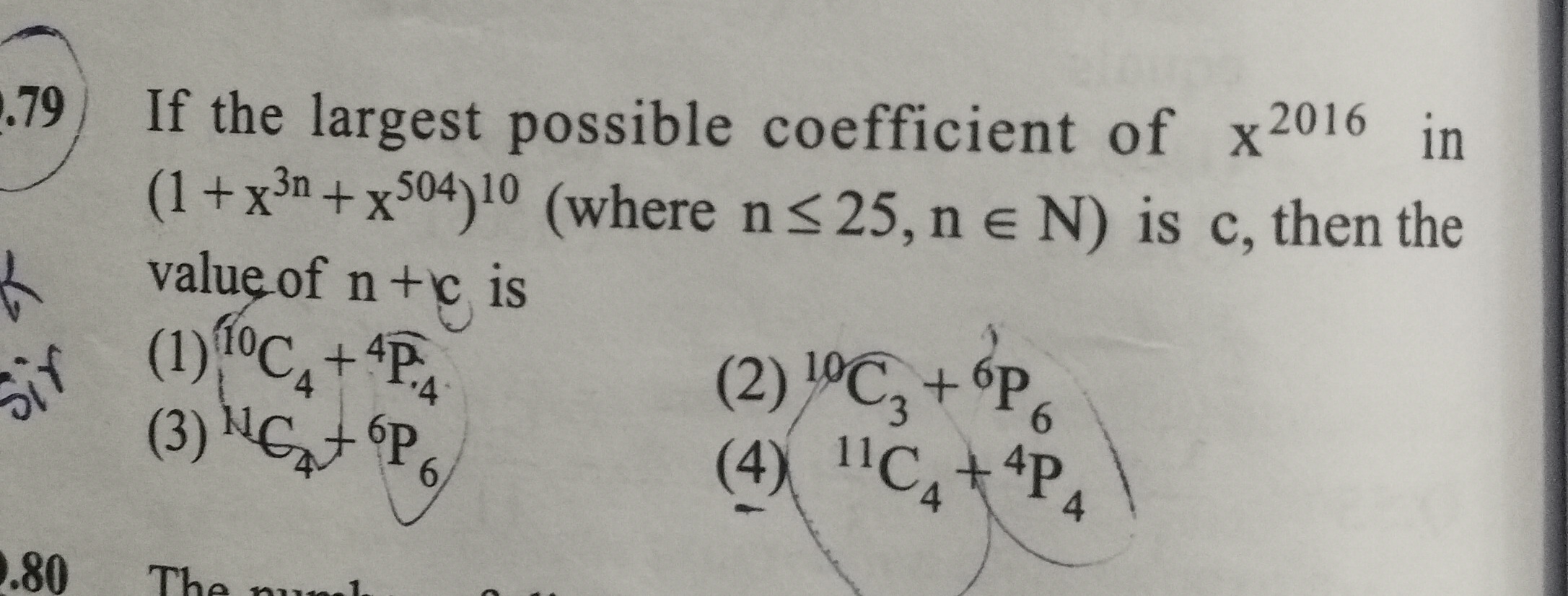Question
Question: If the largest possible coefficient of $x^{2016}$ in $(1 + x^{3n} + x^{504})^{10}$ (where $n \leq 25...
If the largest possible coefficient of x2016 in (1+x3n+x504)10 (where n≤25,n∈N) is c, then the value of n + c is

10C4+4P4
10C3+6P6
11C4+6P6
11C4+4P4
11C4+4P4
Solution
The general term in the expansion of (1+x3n+x504)10 is given by the multinomial theorem: p!q!r!10!(1)p(x3n)q(x504)r=p!q!r!10!x3nq+504r where p,q,r are non-negative integers such that p+q+r=10.
We are looking for the coefficient of x2016, so we must have: 3nq+504r=2016 Dividing the equation by 3, we get: nq+168r=672 We are given that n is a natural number and n≤25, so 1≤n≤25. Also, q and r are non-negative integers, and q+r≤10 (since p=10−q−r≥0).
From nq+168r=672, since nq≥0, we have 168r≤672, which implies r≤168672=4. So, possible values for r are 0,1,2,3,4.
Case 1: r=4 nq+168(4)=672⟹nq=0. Since n≥1, q must be 0. The condition q+r≤10 becomes 0+4≤10, which is satisfied. For q=0,r=4, we get p=10−0−4=6. The triplet (p,q,r)=(6,0,4) is valid for any n in the range 1≤n≤25. The coefficient for this triplet is 6!0!4!10!=4×3×2×110×9×8×7=210.
Case 2: r=3 nq+168(3)=672⟹nq=168. The condition q+r≤10 becomes q+3≤10, so q≤7. We need to find n (1≤n≤25) such that nq=168 and q≤7.
- If q=1,n=168 (invalid n)
- If q=2,n=84 (invalid n)
- If q=3,n=56 (invalid n)
- If q=4,n=42 (invalid n)
- If q=5,n=168/5 (not integer)
- If q=6,n=28 (invalid n)
- If q=7,n=168/7=24. This is a valid value for n (1≤24≤25). So, for n=24, we have q=7,r=3. This gives p=10−7−3=0. The triplet (p,q,r)=(0,7,3) is valid only for n=24. The coefficient for this triplet is 0!7!3!10!=3×2×110×9×8=120.
Case 3: r=2 nq+168(2)=672⟹nq=336. We need q≤10−2=8. If q=8,n=336/8=42 (invalid n). No valid n in the range 1≤n≤25.
Case 4: r=1 nq+168(1)=672⟹nq=504. We need q≤10−1=9. If q=9,n=504/9=56 (invalid n). No valid n in the range 1≤n≤25.
Case 5: r=0 nq+168(0)=672⟹nq=672. We need q≤10−0=10. If q=10,n=67.2 (not integer). No valid n in the range 1≤n≤25.
For any n such that 1≤n≤25 and n=24, the only way to form x2016 is using the triplet (p,q,r)=(6,0,4), which gives a coefficient of 210. For n=24, we have two ways to form x2016:
- Triplet (p,q,r)=(6,0,4), coefficient = 210.
- Triplet (p,q,r)=(0,7,3), coefficient = 120. The total coefficient for n=24 is 210+120=330.
The largest possible coefficient c is 330, which occurs when n=24. The value of n+c is 24+330=354. Checking the options: Option (4) is 11C4+4P4=4!7!11!+0!4!=330+24=354. Thus, c=11C4 and n=4P4.
